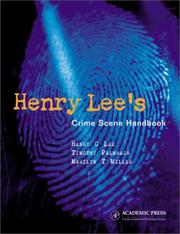| Listing 1 - 8 of 8 |
Sort by
|
Book
ISBN: 0128128453 0128128461 0124058736 0124051979 1306213096 9780124058736 9781306213097 9780124051973 9780128128466 9780128128459 Year: 2014 Publisher: Oxford : Academic Press,
Abstract | Keywords | Export | Availability | Bookmark
 Loading...
Loading...Choose an application
- Reference Manager
- EndNote
- RefWorks (Direct export to RefWorks)
This lab manual provides information, examples, and exercises for all aspect of crime scene investigation. The exercises will teach the proper techniques for securing, documenting, and searching a crime scene, how to visualize or enhance the evidence found, how to package and preserve the evidence, and how to reconstruct what happened at the crime scene. This manual is intended to accompany any textbook in crime scene investigation. Written by a former crime scene investigator and forensic scientist, the information is practical, straightforward, and will be immediately applicable. Learn a
Crime scene searches. --- Criminal investigation. --- Homicide investigation. --- Forensic pathology. --- Forensic sciences. --- Crime detection --- Crime investigation --- Criminal investigations --- Detection of crime --- Investigations --- Law enforcement --- Crime scenes --- Detectives --- Forensic sciences --- Suspects (Criminal investigation) --- Crime scene investigations --- Searches of crime scenes --- Criminal investigation --- Informers
Digital
ISBN: 9780124058736 0124058736 1306213096 9781306213097 Year: 2013 Publisher: Burlington Elsevier Science
Abstract | Keywords | Export | Availability | Bookmark
 Loading...
Loading...Choose an application
- Reference Manager
- EndNote
- RefWorks (Direct export to RefWorks)
This lab manual provides information, examples, and exercises for all aspect of crime scene investigation. The exercises will teach the proper techniques for securing, documenting, and searching a crime scene, how to visualize or enhance the evidence found, how to package and preserve the evidence, and how to reconstruct what happened at the crime scene. This manual is intended to accompany any textbook in crime scene investigation. Written by a former crime scene investigator and forensic scientist, the information is practical, straightforward, and will be immediately applicable. Learn all.
Digital
ISBN: 9780128128466 0128128461 9780128128459 0128128453 Year: 2018 Publisher: London, United Kingdom Academic Press, an imprint of Elsevier
Abstract | Keywords | Export | Availability | Bookmark
 Loading...
Loading...Choose an application
- Reference Manager
- EndNote
- RefWorks (Direct export to RefWorks)
Crime Scene Investigation Laboratory Manual, Second Edition, is written by a former crime scene investigator and forensic scientist who provides practical, straightforward, and immediately applicable best practices. Readers will learn the latest techniques and procedures, including deconstructing first responder contamination, the preliminary walk-through, utilizing associative evidence, enhancing trace, biological and chemical evidence, and reconstructing scenes through wound dynamics, glass fracture patterns, bloodstain patterns, ballistics, and more. This lab manual provides information and examples for all aspects of crime scene investigation. In addition, included exercises teach the proper techniques for securing, documenting and searing a crime scene, how to visualize or enhance the evidence found, how to package and preserve the evidence, and how to reconstruct what happened at the crime scene. This manual is intended to accompany any crime scene investigation textbook.
Book
ISBN: 0128013583 0128012455 9780128013588 9780128012451 9780128012451 Year: 2016 Publisher: London : Elsevier,
Abstract | Keywords | Export | Availability | Bookmark
 Loading...
Loading...Choose an application
- Reference Manager
- EndNote
- RefWorks (Direct export to RefWorks)
Crime scene searches. --- Crime scene investigations --- Searches of crime scenes --- Criminal investigation
Book
ISBN: 0128129611 0128129603 9780128129616 9780128129609 Year: 2019 Publisher: London, United Kingdom : Academic Press, an imprint of Elsevier,
Abstract | Keywords | Export | Availability | Bookmark
 Loading...
Loading...Choose an application
- Reference Manager
- EndNote
- RefWorks (Direct export to RefWorks)
Criminal investigation. --- Crime scene searches. --- Evidence, Criminal. --- Criminal evidence --- Criminal investigation --- Criminal procedure --- Evidence (Law) --- Reasonable doubt --- Crime scene investigations --- Searches of crime scenes --- Crime detection --- Crime investigation --- Criminal investigations --- Detection of crime --- Investigations --- Law enforcement --- Crime scenes --- Detectives --- Forensic sciences --- Suspects (Criminal investigation) --- Informers
Digital
ISBN: 9780128013588 0128013583 0128012455 Year: 2016 Publisher: Amsterdam Elsevier
Abstract | Keywords | Export | Availability | Bookmark
 Loading...
Loading...Choose an application
- Reference Manager
- EndNote
- RefWorks (Direct export to RefWorks)
Digital
ISBN: 9780128129616 0128129611 Year: 2019 Publisher: London, United Kingdom ;San Diego, CA Academic Press, an imprint of Elsevier
Abstract | Keywords | Export | Availability | Bookmark
 Loading...
Loading...Choose an application
- Reference Manager
- EndNote
- RefWorks (Direct export to RefWorks)

ISBN: 0124408303 Year: 2001 Publisher: San Diego, Calif. Academic Press
Abstract | Keywords | Export | Availability | Bookmark
 Loading...
Loading...Choose an application
- Reference Manager
- EndNote
- RefWorks (Direct export to RefWorks)
Public administration --- Criminology. Victimology --- Crime scenes --- Criminal investigation --- Evidence, Expert --- Forensic sciences --- Criminalistics --- Forensic science --- Expert evidence --- Expert testimony --- Expert witness --- Expert witnesses --- Opinion evidence --- Scientific evidence (Law) --- Crime detection --- Crime investigation --- Criminal investigations --- Crime sites --- Scenes of crimes --- Science --- Evidence (Law) --- Witnesses --- Detection of crime --- Investigations --- Law enforcement --- Detectives --- Suspects (Criminal investigation) --- Informers
| Listing 1 - 8 of 8 |
Sort by
|

 Search
Search Feedback
Feedback About UniCat
About UniCat  Help
Help News
News